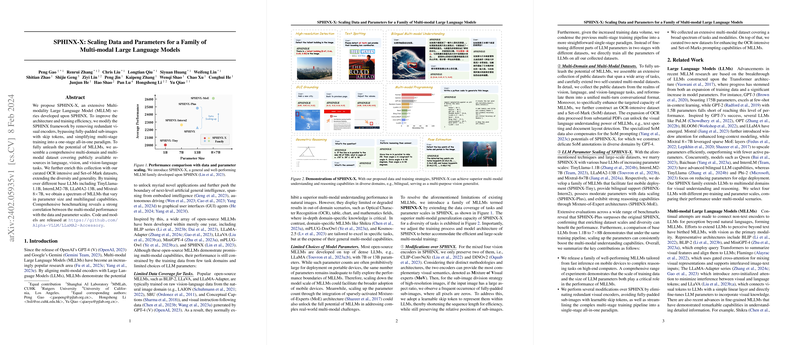Overview of SPHINX-X: A Leap in Multi-modal LLMs
In the burgeoning field of AI, the integration of multi-modality into LLMs presents a remarkable frontier. The paper on SPHINX-X introduces a significant advancement in this space—the development of a series of Multi-modal LLMs (MLLMs) that not only embrace the complexity of multi-modality but also optimize model efficiency and scaling.
Innovations in SPHINX-X Architecture
At the core of SPHINX-X's design are several noteworthy modifications aimed at enhancing the model's performance and efficiency. Firstly, the elimination of redundant visual encoders marks a pivotal step towards streamlining the model's architecture. Specifically, the retention of only two of the initial four visual encoders stands out as a strategic decision to balance computational efficiency with the richness of visual semantics.
Moreover, the introduction of learnable skip tokens to bypass fully-padded sub-images addresses a common efficiency bottleneck in handling high-resolution images. This approach significantly reduces unnecessary computations for sub-images filled with zero-value pixels, thus optimizing processing time.
Perhaps the most significant architectural shift is the transition from a multi-stage training approach to a unified single-stage paradigm. This simplification not only streamlines the training process but also ensures that the model's parameters are uniformly optimized across the entire dataset.
Datasets and Model Scaling
A remarkable contribution of SPHINX-X is its comprehensive multi-domain and multi-modal dataset. This dataset not only spans a broad spectrum of tasks but also includes specially curated OCR-intensive and Set-of-Mark datasets. The inclusion of these datasets enhances SPHINX-X's ability to process and understand a wide array of visual and textual information with exceptional accuracy.
Scaling the parameters of LLMs presents a unique set of challenges and opportunities. SPHINX-X addresses this by presenting models across a spectrum of parameter sizes, ranging from TinyLlama-1.1B, suitable for fast mobile deployment, to Mixtral-8×7B, designed for complex reasoning tasks. This strategic variance in model size ensures that SPHINX-X is not just a one-size-fits-all solution but a versatile toolkit capable of tackling a wide range of applications.
Benchmarking Excellence
The evaluation of SPHINX-X across a variety of benchmark tests reveals its superior performance in areas such as detailed captioning, visual question answering, and document layout detection. Particularly noteworthy is its capability to outperform existing video-based models despite being fundamentally an image-based MLLM. This underscores SPHINX-X's remarkable ability to generalize and apply its understanding across different modalities.
Conclusion
SPHINX-X represents a significant stride forward in the domain of multi-modal LLMs. Its architectural refinements, comprehensive dataset, and strategic parameter scaling collectively propel it to the forefront of AI research. As we continue to unravel the complexities of multi-modality in AI, SPHINX-X serves as a beacon of innovation, efficiency, and versatility.
